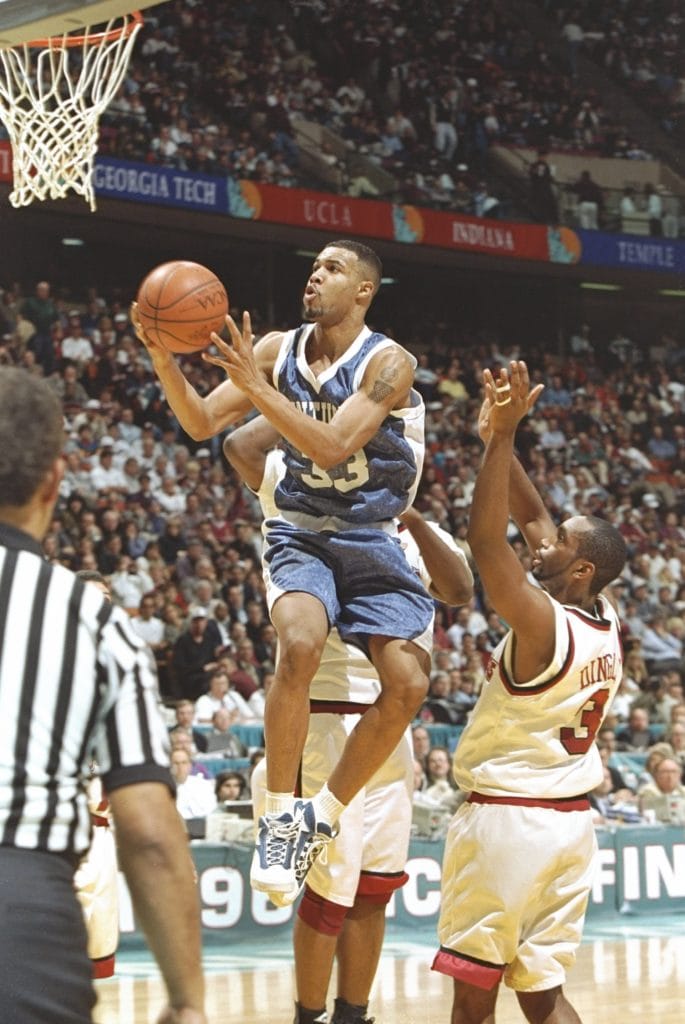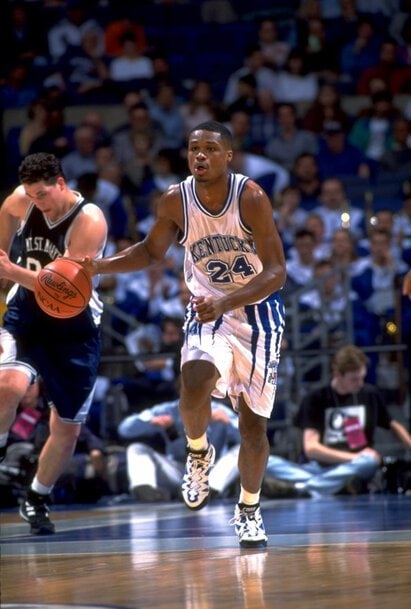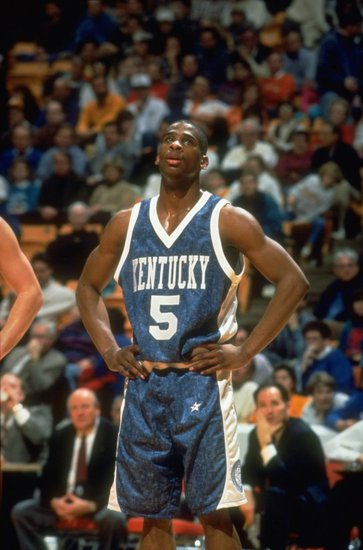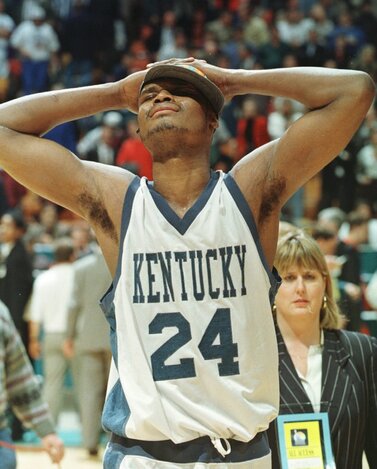Lexington’s legacy of basketball brilliance is defined by big stars and blue branding. In 1996, the team took both to new heights with wild uniforms and a National Championship.
Next fall, Kentucky freshman Robert Dillingham will make his Rupp Arena debut.
Playing for John Calipari in front of the most rabid fanbase in the game, the No. 5 recruit in the nation will have his fair share of NIL interest, taking the court in Wildcats uniforms, fresh from Nike.
In 2023, the Dri-Fit threads built in Beaverton will wick sweat and fit tightly.
It’s a stark contrast to 1996, when that same school wore baggy tanks and trunks made of distressed denim.

Led by Rick Pitino and outfitted by Converse, the 1995-96 Kentucky Wildcats took the term “drip” to new lengths, complete with nine future NBA players on the roster.
With all the talent in the world, the blue-blood program had the wiggle room to wear whatever they wanted because, hey, who was going to beat them?
Exiting an agreement with Apex One, Pitino’s team went all denim for their 34-2 run to the National Championship. While players like Antoine Walker, Derek Anderson, and Tony Delk went on to have successful pro careers, the common thread of nostalgia for some sports fans proved to be their Canadian Tuxedo uniforms.
After a switch in sponsors and 26 years in the vault, the Levi’s leaning shorts are finally coming back, courtesy of a 19nine reboot, due out on Aug. 12 at 11 a.m. ET.
Kind of Blue
In 1989, Pitino took over the historic Kentucky Wildcats program amid scandal as the NCAA was investigating the program for numerous major violations.
Through no fault of Pitino’s, Kentucky was banned from televised games and postseason play for all of his debut year. That season, the team struggled to a 14-14 record, finishing unranked while still somehow exceeding expectations.
By year two, Pitino had turned things around. Big Blue was back in the top 10, and over the course of the early ’90s, he recruited the likes of Jamal Mashburn and Travis Ford while also switching the squad’s sponsorship from Nike back to Converse.
As Kentucky climbed back to its old ways, new styles started sparking sportswear. In the early ’90s, the company Apex One began branding college basketball programs in loud, graphic style, seen most memorably by Felipe Lopez at St. John’s or Kerry Kittles at Villanova.
By the fall of 1994, Apex was outfitting Kentucky in wild uniforms, with Converse providing the kicks.

“People were trying crazy stuff in the early ’90s with Apex,” Josh Barnett, owner of vintage college apparel company 19nine, told Boardroom. “St. John’s, Villanova, and Minnesota were coming out with crazy designs and it was the era for it.”
In May of 1995, Converse bought Apex One for $51M, allowing for an integrated head-to-toe apparel program, set to be led by Arkansas and Kentucky.
Infamously, Converse closed down Apex One faster than it consumed the brand. By August 1995, the Chevron-branded company closed shop on the daring designers they had just hired, right before the college basketball season started.
As Kentucky rolled out its Untouchables lineup, the school’s uniform department drew inspiration from the Apex generation’s loud designs, even if the marking didn’t appear.
Clad in blue denim away uniforms and offset home alternates, the 1995-96 Kentucky Wildcats were disruptive in aesthetic and absolutely loaded on the court.
“They had nine NBA dudes on that team,” Barnett said. “Growing up in Southern Indiana, there’s a lot of Kentucky fans. I remember driving around and my dad was listening to sports talk radio. They said that Kentucky’s second team in ’96 was good enough to be the second-ranked basketball team in the country. So if you just took their bench, they were the No. 2 team in the country.”
Much like Calipari’s Kentucky team from 2015 that had Karl-Anthony Towns starting at center and Devin Booker coming off the bench, the ’96 Wildcats were assumed to be unbeatable by media and fans alike.

The Kentucky Untouchables handled No. 14 ranked Maryland in their home opener, with Mark Pope pouring in 26 points and Tony Delk adding 21.
Shortly after, they met their match.
“They got beat by UMass in their second game of the year and nobody knew that UMass was going to be that good,” Barnett said. “That was Camby and Calipari, as funny as that may sound. Then they won 27 straight and don’t get beat again until Mississippi State. They lost two games all year and both of them were Final Four teams that year.”
The ’96 Wildcats ended up cutting down the nets on April 1, 1996, beating a John Wallace-led Syracuse team. Carrying the weight of great expectations and the audacity of denim uniforms, four players declared for the NBA Draft that spring, with three chosen in the 1st Round.
The next season, Kentucky returned to the National Championship game, despite a roster makeover.
Though coaches, sponsors, and personnel have all changed since 1996, the Wildcats have spent more time atop the totem pole of college hoops than not since Pitino took over in ’89.
All the while, the denim uniforms have remained in the vault. Until now.
Comeback Cats
Making denim basketball shorts may have been an aesthetic stretch in the ’90s, but it’s not much easier in 2022.
As the global supply chain still recovers from the pandemic, sourcing unusual material is no easy task. Thankfully for Barnett and his team at 19nine, they’d done the legal work on the back end before getting help from their fan base.
“We got the licensing about a year ago,” Barnett shared, in regard to UK. “We knew as soon as we got it, we had to do the Kentucky Denims.”
To tease the market, 19nine rolled out the ’95 Kentucky shorts designed by Apex. Additionally, they launched an archival pair from the 1970s tied to the days of Jack Givens.
By keeping the denim drop in their back pocket, Barnett aimed to give Wildcat fans what they wanted before what they craved.
“Kentucky basketball fans are very much traditionalists,” Barnett said. “Kentucky basketball fans are like Alabama football fans. We actually see that in our sales. The ’78 Kentucky shorts sold out in our presale, while it took a little longer for the ’95 Apex pair to sell because I think Kentucky fans identify more with tradition.”

As the ’78 and ’95 shorts were released — and then sold out — Barnett and his team took on the tall task of recreating the infamous denim aesthetic on their pocketed aero mesh shorts.
“We knew it was going to take a lot of time to get the pattern right,” Barnett said. “The graphics are sublimated. We were able to get a customer to send in his Converse pair from ’96. We ran those through our scanners to get the pattern to match.”
Originally, Barnett and his team intended to roll out the ’96 Kentucky away shorts as part of their Legacy program that launched in Spring 2022 which offered one-to-one authentic remakes of archival game shorts.
However, fabric constraints made the away remake a tough task. It instead provided the outlet for a follow-up.

“There’s so much denim, it’s hard to source as an authentic Legacy pair,” Barnett said. “In our research, we found out that on the originals, it wasn’t actually denim. It was a lighter, more elastic material. The plan this Holiday Season is to come out with the Legacy pair of the Kentucky ’96 in white, because there’s less denim, so it won’t be a jean short essentially.”
Still, once those pocketed pairs release, they won’t be around for long.
“I think these are going to be gone within a half hour of the launch,” he predicted.
The nostalgia surrounding the daring denim shorts and Kentucky’s iconic Untouchables lineup is a classic case study in odd old styles becoming more beloved as time goes on. Barnett notes that many fans who buy up loud styles from the ’90s — like Nova’s Apex shorts — claim to have hated them growing up, but love them now.
“These things have a very special place in college basketball lore and in Kentucky fans’ hearts because of how good the team was,” Barnett said. “If that team goes 8-26? They burn these uniforms forever. But since it was one of the greatest teams of all time? There’s a special place in Kentucky fans’ hearts.”